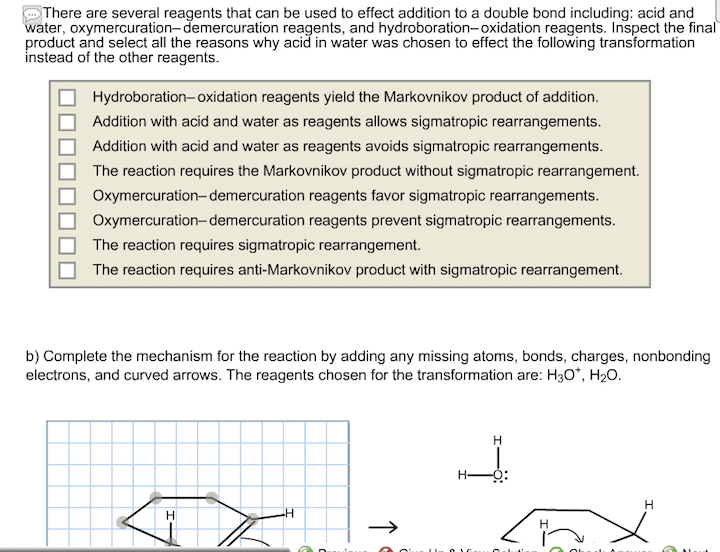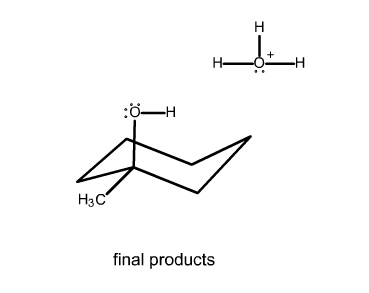1) There are several reagents that can be used to effect addition to a double bond, including: acid and water, oxymercuration–demercuration reagents, and hydroboration–oxidation reagents. The transformation shown utilizes oxymercuration–demecuration conditions. The starting material is a 5 carbon chain where there is a double bond between carbons 1 and 2 and a methyl substituent on carbon 3. The first step reacts with mercury diacetate in THF and water. The second step reacts with sodium borohydride and hydroxide. The product is a 5 carbon chain where carbon 2 has a hydroxy group and carbon 3 has a methyl group. Inspect the final product and select all the reasons why oxymercuration–demercuration was chosen to effect the following transformation instead of the other reagents. Select the correct reasons.
a. Hydroboration–oxidation reagents yield the anti‑Markovnikov product of addition.
b. Oxymercuration–demercuration reagents prevent carbocation rearrangements.
c. The reaction requires the Markovnikov product without carbocation rearrangement.
d. Addition with acid and water as reagents avoids carbocation rearrangements.
e. Addition with acid and water as reagents allows carbocation rearrangements.
f. Hydroboration–oxidation reagents yield the Markovnikov product of addition.
g. The reaction requires the anti‑Markovnikov product with carbocation rearrangement.
h. Oxymercuration–demercuration reagents favor carbocation rearrangements.
2) Complete the mechanism for the reaction by adding curved arrows. Note, the acetate ion is a spectator throughout. Step 1: Draw curved arrows to form the mercurinium ion. Select Draw Rings More Erase Select Draw Rings More Erase Select Draw Rings More Erase C H O Hg
1) There are several reagents that can be used to effect addition to a double bond, including: acid and water, oxymercuration–demercuration reagents, and hydroboration–oxidation reagents. The transformation shown utilizes oxymercuration–demecuration conditions. The starting material is a 5 carbon chain where there is a double bond between carbons 1 and 2 and a methyl substituent on carbon 3. The first step reacts with mercury diacetate in THF and water. The second step reacts with sodium borohydride and hydroxide. The product is a 5 carbon chain where carbon 2 has a hydroxy group and carbon 3 has a methyl group. Inspect the final product and select all the reasons why oxymercuration–demercuration was chosen to effect the following transformation instead of the other reagents. Select the correct reasons.
a. Hydroboration–oxidation reagents yield the anti‑Markovnikov product of addition.
b. Oxymercuration–demercuration reagents prevent carbocation rearrangements.
c. The reaction requires the Markovnikov product without carbocation rearrangement.
d. Addition with acid and water as reagents avoids carbocation rearrangements.
e. Addition with acid and water as reagents allows carbocation rearrangements.
f. Hydroboration–oxidation reagents yield the Markovnikov product of addition.
g. The reaction requires the anti‑Markovnikov product with carbocation rearrangement.
h. Oxymercuration–demercuration reagents favor carbocation rearrangements.
2) Complete the mechanism for the reaction by adding curved arrows. Note, the acetate ion is a spectator throughout. Step 1: Draw curved arrows to form the mercurinium ion. Select Draw Rings More Erase Select Draw Rings More Erase Select Draw Rings More Erase C H O Hg




